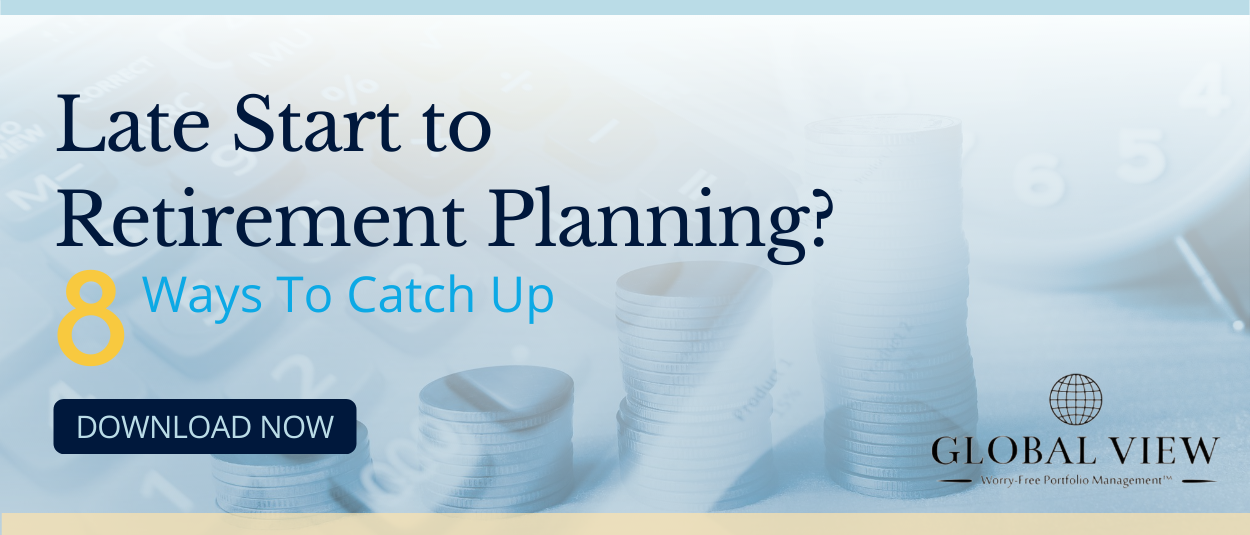Global View Investment Blog
Protecting Your Financial Future Amid Inflation
Given the stock market losses stemming from our current bout with inflation, investors are (rightly) looking for guidance on how to respond. The answer requires some context regarding inflation and the market cycles.
However, at the outset, it’s clear that a knee-jerk reaction of selling all your stocks in a bear market is the worst way to preserve and grow your wealth over the long term. All too often, panic selling locks in losses and causes investors to miss out on the next bull market.
Let’s start by examining the market cycle.
Business and market cycles
Businesses are subject to economic conditions. Markets respond accordingly, albeit often on a different schedule. In other words, markets anticipate future events, which is why bull and bear market cycles usually precede business activity.
Historically, businesses (and markets) have responded to normal rises and falls in economic activity. As a result, noting past trends can guide investment performance during the four phases of the business cycle: early, mid, late, and recession.
Early cycle
The beginning of a new business cycle sees a robust recovery from a recession. Economic indicators reflect the change as industrial production and the gross domestic product move into positive territory on an accelerated basis. Meanwhile, profits grow as credit expands within a low-interest-rate environment. Sales rise sharply during a time of low business inventories.
Early cycles since 1962 have seen stocks deliver an average annual return exceeding 20%. The average length of this phase is about one year. Typically, stocks respond best during the early cycle, aided by low-interest rates, economic improvement, and higher corporate earnings. Bonds and cash benefit less from these conditions, although high-yield corporate bonds often outperform, as do industries that respond well to increased borrowing and low-interest rates. Inflation remains low, coming off the previous recessionary phase and the Fed’s expansionary monetary policy.
Mid-cycle
The mid-cycle is usually the longest of the four phases, characterized by moderate growth. Credit remains strong as economic activity heats up. The Fed begins to moderate monetary policy, shifting to neutral from expansionary.
Many assets do well during this phase, including those sensitive to economic activity (and interest rates) as well as stocks of companies producing products in high demand. The typical annual performance of equities during the mid-cycle has been about 14%. The average phase length has been almost three years.
The mid-cycle sees the most market corrections to the overall uptrend. Bond and cash still underperform, but not as much. The Fed begins to consider hiking interest rates if growth appears unsustainably strong.
Late cycle
Economic activity begins to slow after reaching its peak during this cycle. Tight labor markets and rising inflation prompt higher interest rates. The cycles’ average length has been about 1.5 years, producing annual returns averaging 5%.
During this mature recovery period, interest rates and inflation grow the most, causing investors to shift out of assets sensitive to the economy. Long-term bonds lack strength due to rising inflation, and the yield curve flattens or goes positive. Naturally, inflation-sensitive investments like utility and energy stocks do best in this environment. Cash performs well, but investors should not change their asset allocations drastically during this phase to chase late-cycle opportunities.
Are You Ready for 2023’s Changes to Social Security? Now’s the Time To Get Started With the Basics for Your Retirement.
Recessionary phase
This is the opposite of the early phase: Profits decline and may go negative economic activity contracts, and credit becomes tight. Business inventories fall, as do interest rates. This is usually the shortest phase, averaging an annual length of just under a year and returning -15%. Interest rates and inflation tumble, providing a suitable environment for investment-grade and government bonds that outperform stocks during the recession.
Not all stocks suffer, as defensive ones (e.g., companies producing electricity, toothpaste, prescription drugs, and so on) outperform economically-sensitive ones due to consumers cutting discretionary spending. Investors often prefer dividend-paying stocks during this phase while shunning interest-sensitive securities.
Discipline is key
 Understanding the major market phases helps to prevent emotional extremes that often lead to investment mistakes. It is the job of fiduciary investment advisors to protect their clients from pouring into expensive stocks and selling cheap ones. The opposite approach may sound better, but both attempt to time the market, a risky endeavor.
Understanding the major market phases helps to prevent emotional extremes that often lead to investment mistakes. It is the job of fiduciary investment advisors to protect their clients from pouring into expensive stocks and selling cheap ones. The opposite approach may sound better, but both attempt to time the market, a risky endeavor.
We believe the most productive approach to long-term wealth accumulation is to allocate your investment capital across a wide range of diversified assets. Many investors are familiar with the 60% stock/ 40% bond formula, but we feel it’s too simplistic and insensitive to investors’ unique situations.
In addition, a one-size-fits-all approach glosses over the unique aspects of each business cycle. For example, faster inflation tends to shorten business cycles, making it harder for equities to reach new highs following the inevitable pullbacks. The result is often lackluster stock performance and more protracted recessions.
But central banks have become more sophisticated stewards of monetary policy in the wake of inflation, a trend that continues. A “soft-landing” of the business cycle is not always achievable, but the Fed may have gained valuable experience toward that end.
What does this mean for investors?
It means hold tight. Long-term investments almost always outperform attempts to time the market. Timing, meanwhile, usually leads to emotional investing that damages returns. The S&P 500 almost always posts positive returns over 20-year periods. Investing for the long term reduces your trading costs and compounds your earnings.
Your asset allocations should be designed to allow you to ride out market cycles without succumbing to fear. Our firm is a financial advisor in Greenville and Columbia, SC, that can tailor your investment portfolio to reflect the most important long-term factors, including your age, investment goals, risk tolerance, and the amount of capital you can invest.
We understand the need for broad diversification while respecting the risks of each asset class. Additionally, we can potentially help you grow and protect your wealth now and through your retirement. Contact us today.

Written by Adam Wiles
Adam is a Partner at Global View. Adam’s primary focus is on investment strategy, retirement planning, risk management, and new client identification. He has extensive experience and training in identifying client’s needs and explaining the solutions that meet those needs. He worked with Merrill Lynch for 2 years prior to joining Global View. Prior to Merrill Lynch, Adam worked 10 years, in several trading capacities, within the Commodity Lumber business.
Are you on track for the future you want?
Schedule a free, no-strings-attached portfolio review today.
Talk With Us






